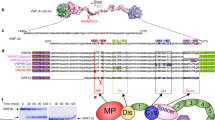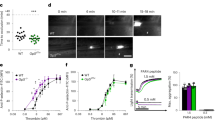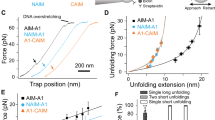Abstract
The interaction of the plasma protein vitronectin with plasminogen activator inhibitor-1 (PAI-1) is central to human health. Vitronectin binding extends the lifetime of active PAI-1, which controls hemostasis by inhibiting fibrinolysis and has also been implicated in angiogenesis. The PAI-1–vitronectin binding interaction also affects cell adhesion and motility. For these reasons, elevated PAI-1 activities are associated both with coronary thrombosis and with a poor prognosis in many cancers. Here we show the crystal structure at a resolution of 2.3 Å of the complex of the somatomedin B domain of vitronectin with PAI-1. The structure of the complex explains how vitronectin binds to and stabilizes the active conformation of PAI-1. It also explains the tissue effects of PAI-1, as PAI-1 competes for and sterically blocks the interaction of vitronectin with cell surface receptors and integrins. Structural understanding of the essential biological roles of the interaction between PAI-1 and vitronectin opens the prospect of specifically designed blocking agents for the prevention of thrombosis and treatment of cancer.
This is a preview of subscription content, access via your institution
Access options
Subscribe to this journal
Receive 12 print issues and online access
$189.00 per year
only $15.75 per issue
Buy this article
- Purchase on Springer Link
- Instant access to full article PDF
Prices may be subject to local taxes which are calculated during checkout


Similar content being viewed by others
Accession codes
References
Preissner, K.T. et al. Structural requirements for the extracellular interaction of plasminogen activator inhibitor-1 with endothelial cell matrix-associated vitronectin. J. Biol. Chem. 265, 18490–18498 (1990).
Kohler, H.P. & Grant, P.J. Plasminogen activator inhibitor type 1 and coronary heart disease. N. Engl. J. Med. 342, 1792–1801 (2000).
McMahon, G.A. et al. Plasminogen activator inhibitor-1 regulates tumor growth and angiogenesis. J. Biol. Chem. 276, 33964–33968 (2001).
Devy, L. et al. The pro- or antiangiogenic effect of plasminogen activator inhibitor 1 is dose dependent. FASEB J. 16, 147–154 (2002).
Seiffert, D. & Loskutoff D.J. Evidence that type 1 plasminogen activator inhibitor binds to the somatomedin domain of vitronectin. J. Biol. Chem. 266, 2824–2830 (1991).
Stefansson, S. & Lawrence, D.A. The serpin PAI-1 inhibits cell migration by blocking integrin αVβ3 binding to vitronectin. Nature 383, 441–443 (1996).
Look, M.P. et al. Pooled analysis of prognostic impact of urokinase-type plasminogen activator and its inhibitor PAI-1 in 8377 breast cancer patients. J. Natl. Cancer Inst. 94, 116–128 (2002).
Hekman, C.M. & Loskutoff, D.J. Endothelial cells produce a latent inhibitor of plasminogen activators that can be activated by denaturants. J. Biol. Chem. 260, 11581–11587 (1985).
Mottonen, J. et al. Structural basis of latency in plasminogen-activator inhibitor-1. Nature 355, 270–273 (1992).
Lawrence, D.A. et al. Characterization of the binding of different conformational forms of plasminogen activator inhibitor-1 to vitronectin. J. Biol. Chem. 272, 7676–7680 (1997).
Schroeck, F., Arroyo de Prada, N., Sperl, S., Schmitt, M. & Magdolen, V. Interaction of plasminogen activator inhibitor type-1 (PAI-1) with vitronectin (Vn): mapping the binding sites on PAI-1 and Vn. Biol. Chem. 383, 1143–1149 (2002).
Okumura, Y. et al. Kinetic analysis of the interaction between vitronectin and the urokinase receptor. J. Biol. Chem. 277, 9395–9404 (2002).
Berkenpas, M.B., Lawrence, D.A. & Ginsburg, D. Molecular evolution of plasminogen activator inhibitor-1 functional stability. EMBO J. 14, 2969–2977 (1995).
Lawrence, D.A., Berkenpas, M.B., Palaniappan, S., & Ginsburg, D. Localization of vitronectin binding domain in plasminogen activator inhibitor-1. J. Biol. Chem. 269, 15223–15228 (1994).
Sigurdardottir, O. & Wiman, B. Studies on the interaction between plasminogen activator inhibitor-1 and vitronectin. Fibrinolysis 6, 27–32 (1992).
Deng, G., Curriden, S.A., Wang, S., Rosenberg, S. & Loskutoff, D.J. Is plasminogen activator inhibitor-1 the molecular switch that governs urokinase receptor-mediated cell adhesion and release? J. Cell Biol. 134, 1563–1571 (1996).
Xiong, J.-P. et al. Crystal structure of the extracellular segment of integrin αVβ3 in complex with an Arg-Gly-Asp ligand. Science 296, 151–155 (2002).
Bajou, K. et al. Absence of host plasminogen activator inhibitor 1 prevents cancer invasion and vascularization. Nat. Med. 4, 923–928 (1998).
Harbeck, N. et al. Clinical relevance of the plasminogen activator inhibitor type 1 — a multifaceted proteolytic factor. Onkologie 24, 238–244 (2001).
Czekay, R.-P., Aertgeerts, K., Curriden, S.A. & Loskutoff, D.J. Plasminogen activator inhibitor-1 detaches cells from extracellular matrices by inactivating integrins. J. Cell Biol. 160, 781–791 (2003).
Gils, A. et al. Characterization and comparative evaluation of a novel PAI-1 inhibitor. Thromb. Haemost. 88, 137–143 (2002).
Yoneda, A., Ogawa, H., Kojima, K. & Matsumoto, I. Characterization of the ligand binding activities of vitronectin: interaction of vitronectin with lipids and identification of the binding domains for various ligands using recombinant domains. Biochemistry 37, 6351–6360 (1998).
Sharp, A.M. et al. The active conformation of plasminogen activator inhibitor 1, a target for drugs to control fibrinolysis and cell adhesion. Structure Fold. Des. 7, 111–118 (1999).
Otwinowski, Z. & Minor, W. Processing of X-ray diffraction data collected in oscillation mode. Methods Enzymol. 276, 307–326 (1997).
Read, R.J. Pushing the boundaries of molecular replacement with maximum likelihood. Acta Crystallogr. D 57, 1373–1382 (2001).
Read, R.J. Improved Fourier coefficients for maps using phases from partial structures with errors. Acta Crystallogr. A 42, 140–149 (1986).
Jones, T.A., Zou, J.Y., Cowan, S.W. & Kjeldgaard, M. Improved methods for building protein models in electron density maps and the location of errors in these models. Acta Crystallogr. A 47, 110–119 (1991).
Winn, M.D., Isupov, M.N. & Murshudov, G.N. Use of TLS parameters to model anisotropic displacements in macromolecular refinement. Acta Crystallogr. D 57, 122–133 (2001).
Collaborative Computational Project, Number 4. The CCP4 suite: programs for protein crystallography. Acta Crystallogr. D 50, 760–763 (1994).
Laskowski, R.A., Moss, D.S. & Thornton, J.M. Main-chain bond lengths and bond angles in protein structures. J. Mol. Biol. 231, 1049–1067 (1993).
Kraulis, P.J. MOLSCRIPT: a program to produce both detailed and schematic plots of protein structures. J. Appl. Crystallogr. 24, 946–950 (1991).
Merritt, E.A. & Bacon, D.J. Raster3D photorealistic molecular graphics. Methods Enzymol. 277, 505–524 (1997).
Esnouf, R.M. An extensively modified version of MolScript that includes greatly enhanced coloring capabilities. J. Mol. Graph. Model. 15, 132–134 (1997).
Acknowledgements
We thank N. Duke for assistance in collecting data at the APS and A. McCoy for advice on fitting the somatomedin B domain to the initial electron density maps. H. Ogawa kindly provided cDNA for vitronectin. Use of the SBC beamline at the APS was supported by the US Department of Energy Office of Biological and Environmental Research. Beamtime at station 14.2 of Daresbury SRS was provided by CLRC Daresbury Laboratory. R.J.R. and R.W.C. were supported by the Wellcome Trust (UK) and J.A.H. by the Medical Research Council (UK) and National Institutes of Health (USA).
Author information
Authors and Affiliations
Corresponding author
Ethics declarations
Competing interests
The authors declare no competing financial interests.
Rights and permissions
About this article
Cite this article
Zhou, A., Huntington, J., Pannu, N. et al. How vitronectin binds PAI-1 to modulate fibrinolysis and cell migration. Nat Struct Mol Biol 10, 541–544 (2003). https://doi.org/10.1038/nsb943
Received:
Accepted:
Published:
Issue Date:
DOI: https://doi.org/10.1038/nsb943



